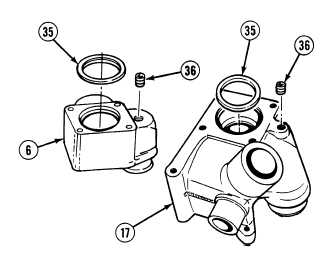|
| |
TM 9-2320-364-20-4
6-45
NOTE
Both left and right seal rings are
replaced the same way.
(20)
Position left and right thermostat
housings (6) and (17) bottom side up.
(21)
Remove and discard seal ring (35) from left
and right thermostat housings (6) and (17).
(22)
Remove plugs (36) from left and right
thermostat housings (6) and (17).
b.
Cleaning/Inspection.
Use care when scraping gasket material not to damage machined surfaces of housing.
(1)
Scrape gasket material from thermostat housing.
Drycleaning Solvent (P-D-680) is TOXIC and flammable. Wear protective goggles, face
shield, and gloves; use only in a well-ventilated area; avoid contact with skin, eyes, and
clothes, and do not breathe vapors. Keep away from heat or flame. Never smoke when
using solvent. The flashpoint for Type II Drycleaning Solvent is 140 degrees F (60 degrees
C) and Type III Drycleaning Solvent is 200 degrees F (93 degrees C). Failure to do so may
result in injury or death to personnel.
If personnel become dizzy while using cleaning solvent, immediately get fresh air and
medical help. If solvent contacts skin or clothes, flush with cold water. If solvent contacts
eyes, immediately flush eyes with water and get immediate medical attention.
(2)
Clean metal parts with drycleaning solvent and wire brush.
Compressed air used for cleaning purposes will not exceed 30 psi (207 kPa). Use only with
effective chip guarding and personal protective equipment (Goggles/shield, gloves, etc.).
(3)
Dry parts with compressed air.
(4)
Inspect housing for cracks.
(5)
Replace all damaged parts.
|

